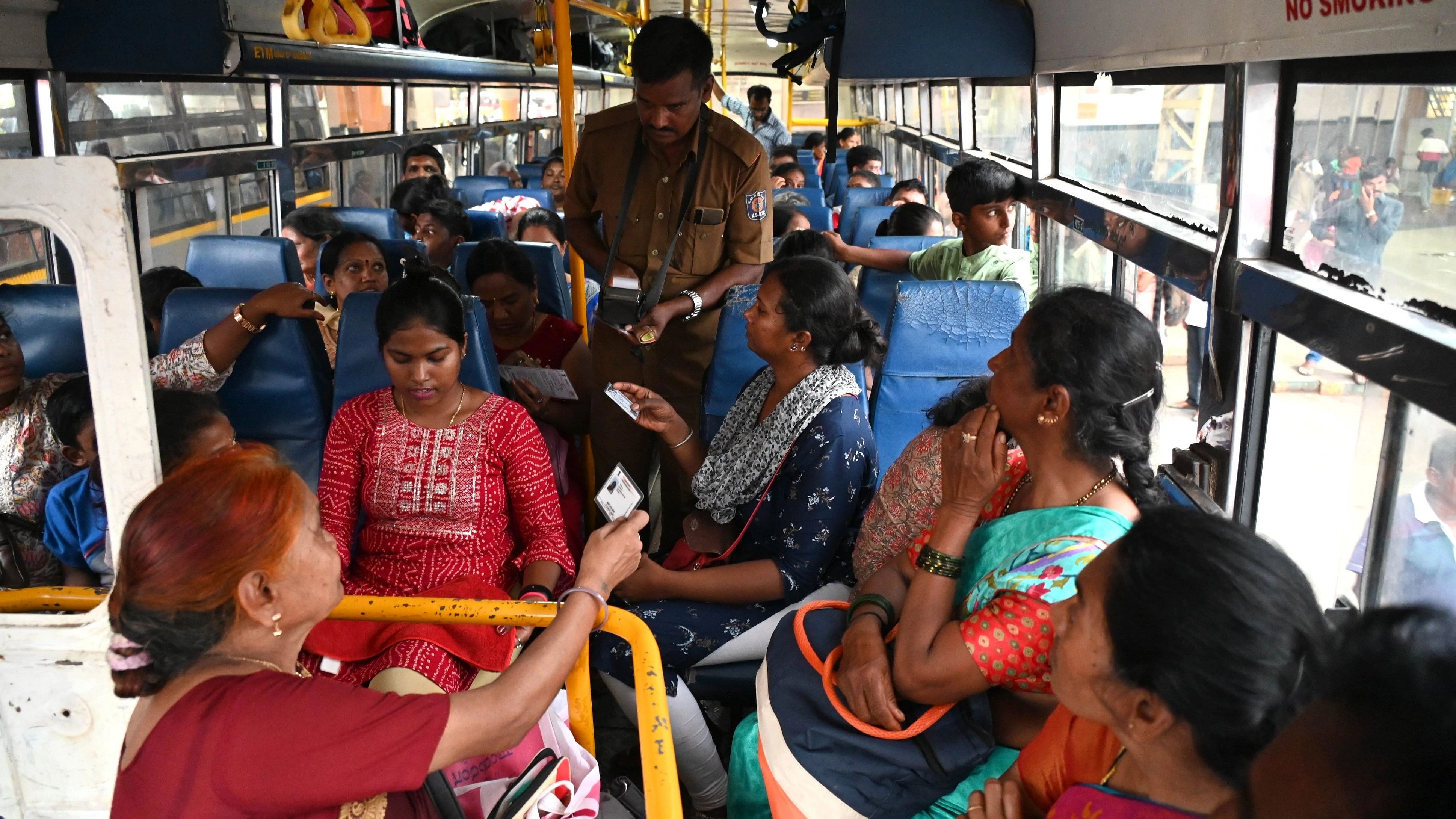
Karnataka’s public buses currently do not adhere to the basic accessibility requirements set out in law. The Rights of Persons with Disabilities Act, 2016, requires Union and state governments to ensure that all public buses are built to be “disabled-friendly".
Credit: DH File Photo
The Shakti scheme has made Karnataka’s state-run public buses accessible to multitudes of women (over 17 crore within a month of its launch as on July 11, 2023), but persons with disabilities—a lot of whom are women—continue to face difficulties in accessing bus transport. It is difficult to climb the high stairway, impossible to board with a wheelchair, and find seating with handrails and supports. Bus drivers rarely wait long enough at bus stops for persons with disabilities to board or deboard.
This happens because Karnataka’s public buses currently do not adhere to the basic accessibility requirements set out in law. The Rights of Persons with Disabilities Act, 2016, requires Union and state governments to ensure that all public buses are built to be “disabled-friendly”, in accordance with automotive industry standards issued under the Central Motor Vehicles Rules, 1989, and the Harmonised Guidelines and Standards for Universal Accessibility in India, 2021. As per these standards and guidelines, buses should have low floors with ramps or hydraulic lifts, priority seats, railings and securing arrangements for wheelchairs, crutches, and walkers that can assist persons with disabilities, or for that matter anyone who may require easier, unhindered access such as the elderly and children.
Despite the above mandates, tenders for the procurement of buses do not incorporate adherence to most basic accessibility requirements. For instance, tender notifications issued in October 2022 by the Bangalore Metropolitan Transport Corporation have been challenged before the Supreme Court, given that they specify a floor height of 1,000 mm (where the technical requirement is to maintain a height between 400 mm and 650 mm), and also because they do not provide
for a wheelchair boarding device. Such “high-floor” buses would not be usable by a sizeable portion of the population as they would be difficult/impossible to board.
Given the success of the Shakti scheme, Karnataka’s road transport corporations (RTCs) are now working to procure at least 1,894 more buses to meet the higher demand and footfall from women. After the implementation of the scheme, there have also been demands to extend free ridership to persons with disabilities. However, providing either free or concessional bus travel is simply of no use to such people if the buses cannot be accessed by them. Moreover, the main objective of the Shakti scheme, which is the financial empowerment of women through free ridership, cannot truly be achieved if it excludes some of the most vulnerable and marginalised women — women with disabilities.
To ensure that the outcomes of the scheme extend beyond free rides and enable lasting changes that promote inclusivity of persons with disabilities, it is imperative that this imminent bus procurement exercise should tender only for buses that meet legally mandated accessibility requirements. Even after the Supreme Court’s order in Rajive Raturi v Union of India and Ors., which referenced the Harmonised Guidelines (of 2016), and directed state and private transport carriers to provide for “easily accessible entry and exit points at bus stops, railway stations and airports” (and set a March 2018 deadline for compliance), there has been no material compliance with the accessibility requirements.
If the tenders floated by the Karnataka state RTCs call for adherence to basic accessibility requirements, such as the need for accessible low-floor buses (that are not more than 400-650 mm off the ground), and which are equipped with foldable ramps, it will make a huge difference to persons with disabilities in accessing the much-needed public bus transport. As an immediate first step, the Karnataka government must ensure that when tenders are issued by RTCs to procure more buses to meet the demands of the Shakti scheme, the tender specifications incorporate adherence to the accessibility requirements laid out in the law, and by the apex court.
Additionally, accessibility of buses should not be limited to just their physical structure but must also be reflected in the awareness and sensitivity of bus staff such as drivers and conductors. While free travel by public bus is a significant step towards inclusivity, the government should bring in disabled-friendly buses that are not just financially, but also structurally, and attitudinally accessible to persons with disabilities. This can be achieved by ensuring that the bus stops at the designated stops, so people do not have to run to catch the bus; the conductors should ensure hassle-free boarding and
assist riders with patience and sensitivity.
One hopes that Karnataka will build on the Shakti scheme by taking a step towards ensuring buses that are, at least in some incremental ways, accessible to persons with disabilities. All buses procured should be accessible and disabled-friendly as mandated from the very first step of the tender specification process.
(The writer is Senior Fellow, Vidhi Centre for Legal Policy)